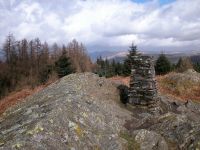Windermere
Sketch map will appear here
Windermere is England's largest lake, measuring some ten miles
in length and half a mile wide on average (though up to a mile wide at
some points). It is a major boating and holiday centre, with the towns
of Windermere and Bowness on its northeast bank and Ambleside at its
northern tip. To the casual tourist Windermere is the Lake District,
and the Lake District is Windermere.
The lake is surrounded by pretty hill country and it was the quality of
the scenery that first brought the lake to the attention of the general
public. In 1847 a railway was built to Windermere town and as a result
it became a significant tourist resort. However, the lake differs from
most others in the national park in that it lays outside the main area
of the fells, which hence form a backdrop to the scenery around the
lake rather than being its primary factor. The lake shores are prettily
wooded for the most part, as are the many islands within the lake. The
country beyond Windermere's western shores is also heavily wooded, much
of it consisting of the huge Grizedale forest plantations. Among the
few villages in the area are Hawkshead, Far Sawrey and Near Sawrey -
the latter was the home of the author Beatrix Potter and the cottage
where she lived and worked is now a museum owned and operated by the
National Trust.
Altough this is not high fell country it is a renowned walking area and
contains several hills of note, among them the noted viewpoint of
Latterbarrow and the Marylins of Claife Heights and Top O' Selside.
There are also many lovely little tarns to be found such as Moss Eccles
and Green Hows, and last but not least the area boasts its own lake,
Esthwaite Water, probably the least known lake in the district.
Gallery Index
Back to Lake District index page
This page last updated 26th April 2006



![]()